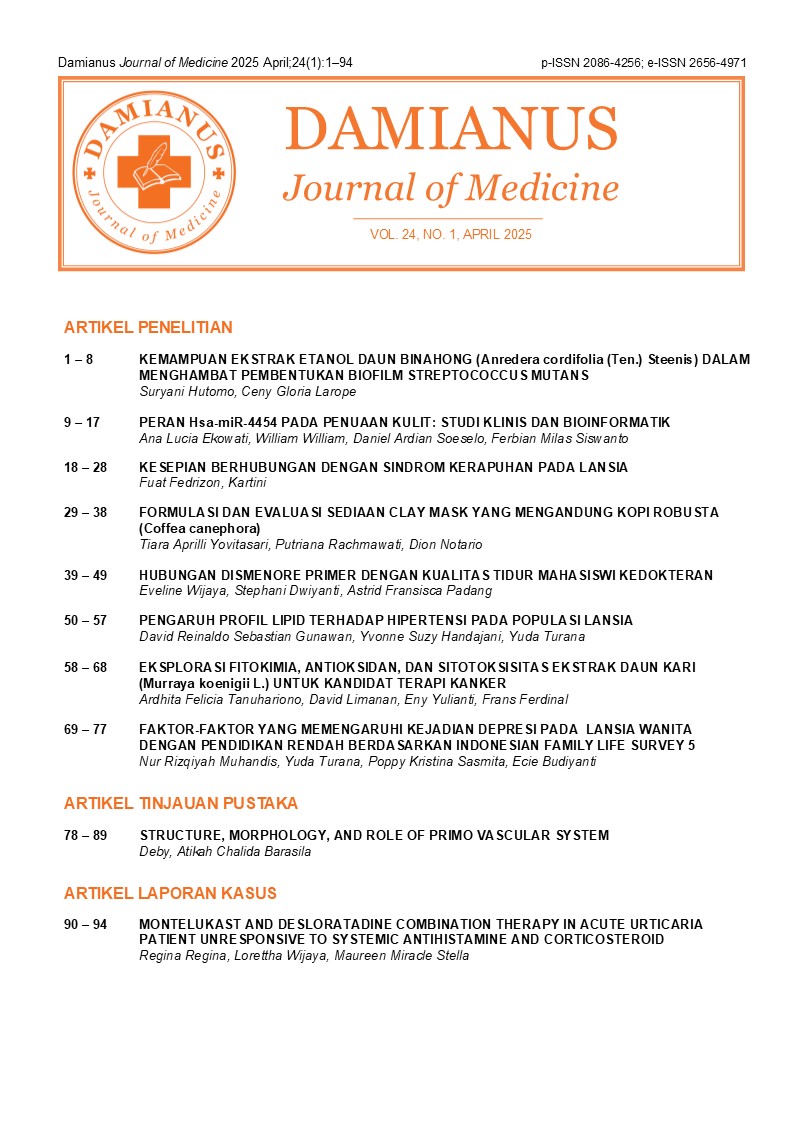Montelukast and desloratadine combination therapy in acute urticaria patient unresponsives to systemic antihistamine and corticosteroid
DOI:
https://doi.org/10.25170/djm.v24i1.3220Keywords:
acute urticaria, antihistamine, antileukotriene, montelukastAbstract
Introduction: Urticaria is a common skin disease, characterized by localized edema that appears suddenly and disappears within 24 hours. Antihitamin-H1 is the drug of choice for urticaria which is sometimes combined with systemic corticosteroids. The use of montelukast in cases of urticaria is still rarely reported.
Case Report: A 21-year-old woman came with complaint of itchy bumps all over her body with a dominant burning sensation since 5 days ago. Complaint remained unchanged even after administering up to four doses of desloratadine and a combination of 16 mg methylprednisolone. The complaint finally improved after the patient was given montelukast 10 mg per day combined with desloratadine 5 mg twice a day.
Discussion: Leukotriene is a lipid mediator that can increase vasopermeability and vasodilation in the skin. The improvement in symptoms that occurred after the combination therapy of montelukast and desloratadine proved the involvement of leukotrienes in the pathogenesis of this patient's case of acute urticaria.
Conclusion: Combination therapy with montelukast and desloratadine may be useful in some cases of acute urticaria. Further studies with sufficient control may be conducted to determine the effectiveness of montelukast in combination with antihistamines for cases of acute urticaria.
Downloads
References
1. Antia C, Baquerizo K, Korman A, Bernstein JA, Alikhan A. Urticaria: A comprehensive review: Epidemiology, diagnosis, and work-up. J Am Acad Dermatol. 2018 Oct;79(4):599-614.
2. Zuberbier T, Aberer W, Asero R, Abdul Latiff AH, Baker D, Ballmer-Weber B, et al. The EAACI/GA2LEN/EDF/WAO guideline for the definition, classification, diagnosis and management of urticaria. Allergy. 2018 Jul 1;73(7):1393–414.
3. Vestergaard C, Toubi E, Maurer M, Triggiani M, Ballmer-Weber B, Marsland A, et al. Treatment of chronic spontaneous urticaria with an inadequate response to H1-antihistamines: an expert opinion. Eur J Dermatol. 2017 Feb 1;27(1):10-9.
4. Sweetlin S, Denish S. Efficacy of montelukast and ranitidine as an add on therapy for chronic urticaria. Int J Clin Pharmacol & Toxicol. 2018;7(1):290-295.
5. Alkeraye S, AlRuhaimi DK. The addition of montelukast for the treatment of chronic idiopathic urticaria. Cureus. 2021 Jul 3;13(7):e16137.
6. Barbosa JS, Almeida Paz FA, Braga SS. Monte-lukast medicines of today and tomorrow: from molecular pharmaceutics to technological formulations. Drug Delivery. 2016;23(9):3257-3265.
7. Khan S, Lynch N. Efficacy of montelukast as added therapy in patients with chronic idiopathic urticaria. Inflamm Allergy Drug Targets. 2012;11(3):235-43.
8. de Silva NL, Damayanthi H, Rajapakse AC, Rodrigo C, Rajapakse S. Leukotriene receptor antagonists for chronic urticaria: a systematic review. Allergy Asthma Clin Immunol. 2014;10(1):24.
9. Ortonne JP. Urticaria and its subtypes: The role of second-generation antihistamines. Eur J Intern Med. 2012;23(1):26-30.
10. Gonçalo M, Gimenéz-Arnau A, Al-Ahmad M, Ben-Shoshan M, Bernstein JA, Ensina LF, et al. The global burden of chronic urticaria for the patient and society. Br J Dermatol. 2021 Feb 1;184(2):226–36.
11. Bulur I, Gokalp H. Contact urticaria. In: Kartal SP, Kutlubay Z, editors. A comprehensive review of urticaria and angioedema [book on the Internet]. London: Intech Open; 2017;p.47-59.
12. Zhai H, Zheng Y, Fautz R, Fuchs A, Maibach HI. Reactions of non-immunologic contact urticaria on scalp, face, and back. Skin Res Technol. 2012 Nov;18(4):436–41.
13. Guimarães FR, Sales-Campos H, Nardini V, da Costa TA, Fonseca MTC, Júnior VR, et al. The inhibition of 5-Lipoxygenase (5-LO) products leukotriene B4 (LTB4) and cysteinyl leukotrienes (cysLTs) modulates the inflammatory response and improves cutaneous wound healing. Clin Immunol. 2018 May 1;190:74–83.
14. Gomułka K, Panaszek B. Contact urticaria syndrome caused by haptens. Postepy Dermatol Alergol. 2014 May;31(2):108-12.
15. Zukiewicz-Sobczak WA, Adamczuk P, Wróblewska P, Zwoliński J, Chmielewska-Badora J, Krasowska E, et al. Allergy to selected cosmetic ingredients. Postepy Dermatol Alergol. 2013 Oct;30(5):307-10.
16. McFadden J. Immunologic contact urticaria. Immu-nol Allergy Clin North Am. 2014 Feb;34(1):157-67.
17. Sadik CD, Sezin T, Kim ND. Leukotrienes orchestrating allergic skin inflammation. Exp Dermatol. 2013 Nov;22(11):705–9.
18. Altman K, Chang C. Pathogenic intracellular and autoimmune mechanisms in urticaria and angioedema. Clin Rev Allergy and Immunol. 2013;45(1):47–62.
19. Wan KS, Chang Y sen. Efficacy of leukotriene receptor antagonist with anti-H1 receptor antagonist plus anti-H2 receptor antagonist for treatment of refractory chronic idiopathic urticaria. J Dermatolog Treat. 2014;25(6):459–61.
20. Kaplan AP. Chronic spontaneous urticaria: Pathogenesis and treatment considerations. Allergy Asthma Immunol Res. 2017;9(6):477-482.
21. Greenberger PA. Chronic urticaria: New management options. World Allergy Organ J. 2014;7(1)31.
Downloads
Published
Issue
Section
License
Copyright (c) 2025 Damianus Journal of Medicine

This work is licensed under a Creative Commons Attribution-ShareAlike 4.0 International License.














